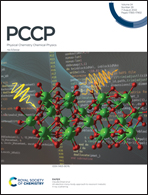Electrocatalytic activity of a β-Sb two-dimensional surface for the hydrogen evolution reaction†
Abstract
Hydrogen energy is considered to be one of the most promising clean energy sources. The development of highly active, low-cost catalysts, and good stability is essential for hydrogen production. Herein, the catalytic activity of a two-dimensional β-Sb surface doped with main-group elements (N, P, As, O, S, Se, and Te) for the hydrogen evolution reaction (HER) was investigated by density functional theory, and the catalytic activity of the β-Sb monolayer can be improved by doping group VIA atoms. The catalytic activity of Se@Sb and O@Sb structures at the doping concentration of 2.78% and the S@Sb structure at the doping concentration of 5.56% may be as good as the Pt(111) surface, while keeping energetically stable. In addition, the catalytic performance could be optimized under biaxial strain. Further analysis suggests that the activity is caused by hole states in the lone pair electrons, which are created by the group VIA atom dopants. And our work also reveals that the density of states at the Fermi level could be an appropriate descriptor of the hydrogenation Gibbs free energy. This work not only proposes a novel non-platinum HER catalyst but also provides physical foundations for further application on antimonene-based catalysts.



 Please wait while we load your content...
Please wait while we load your content...